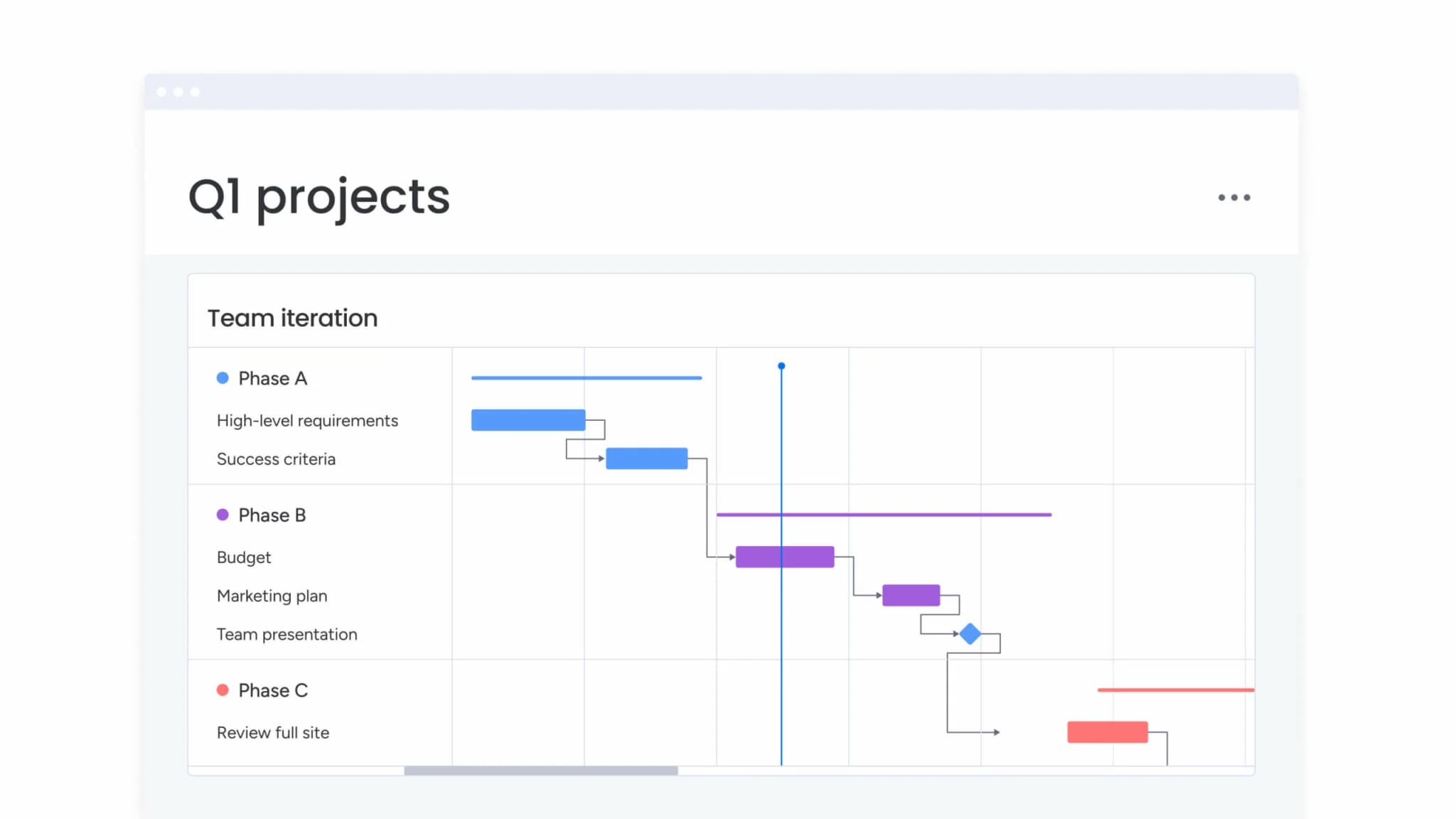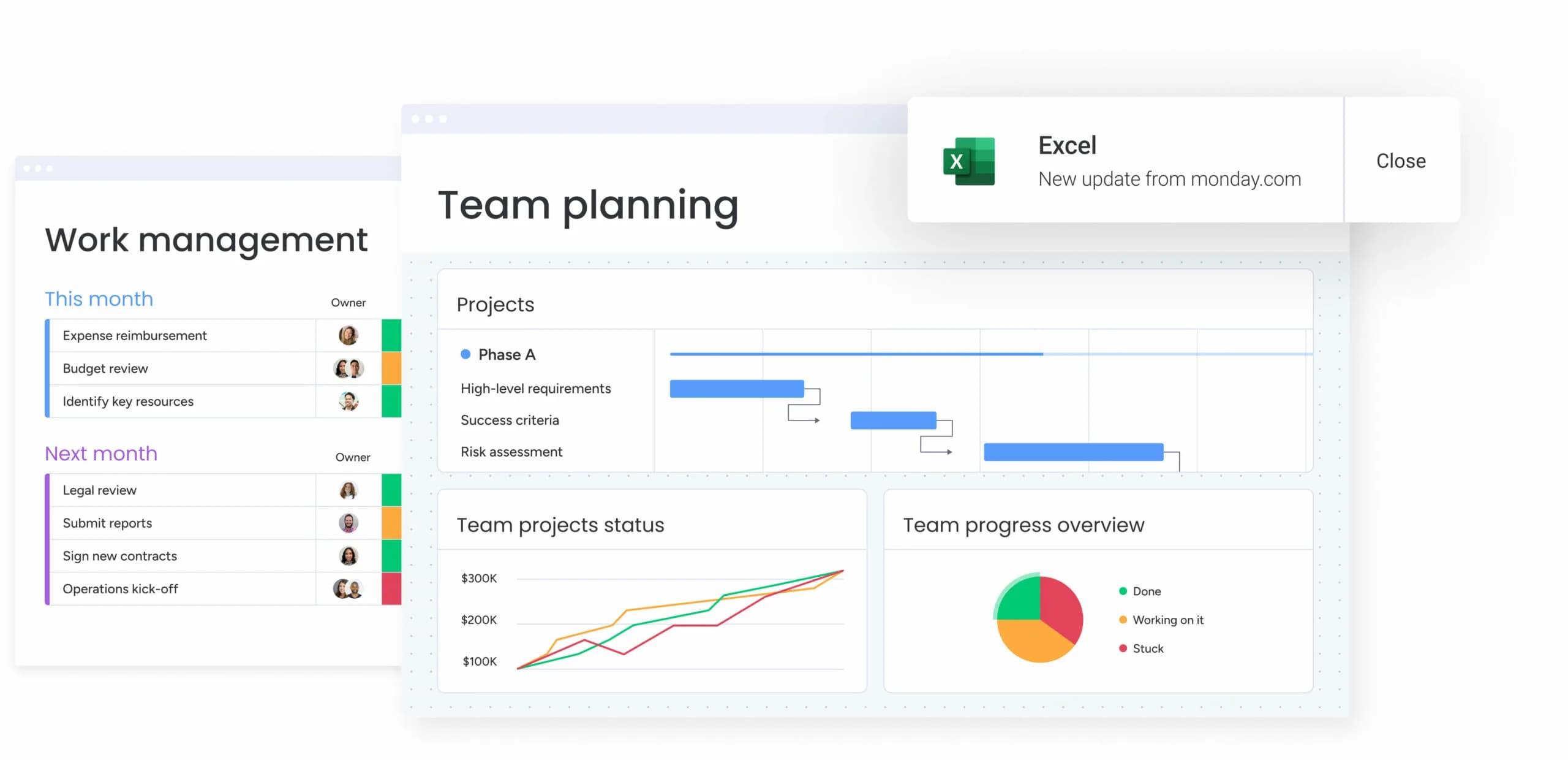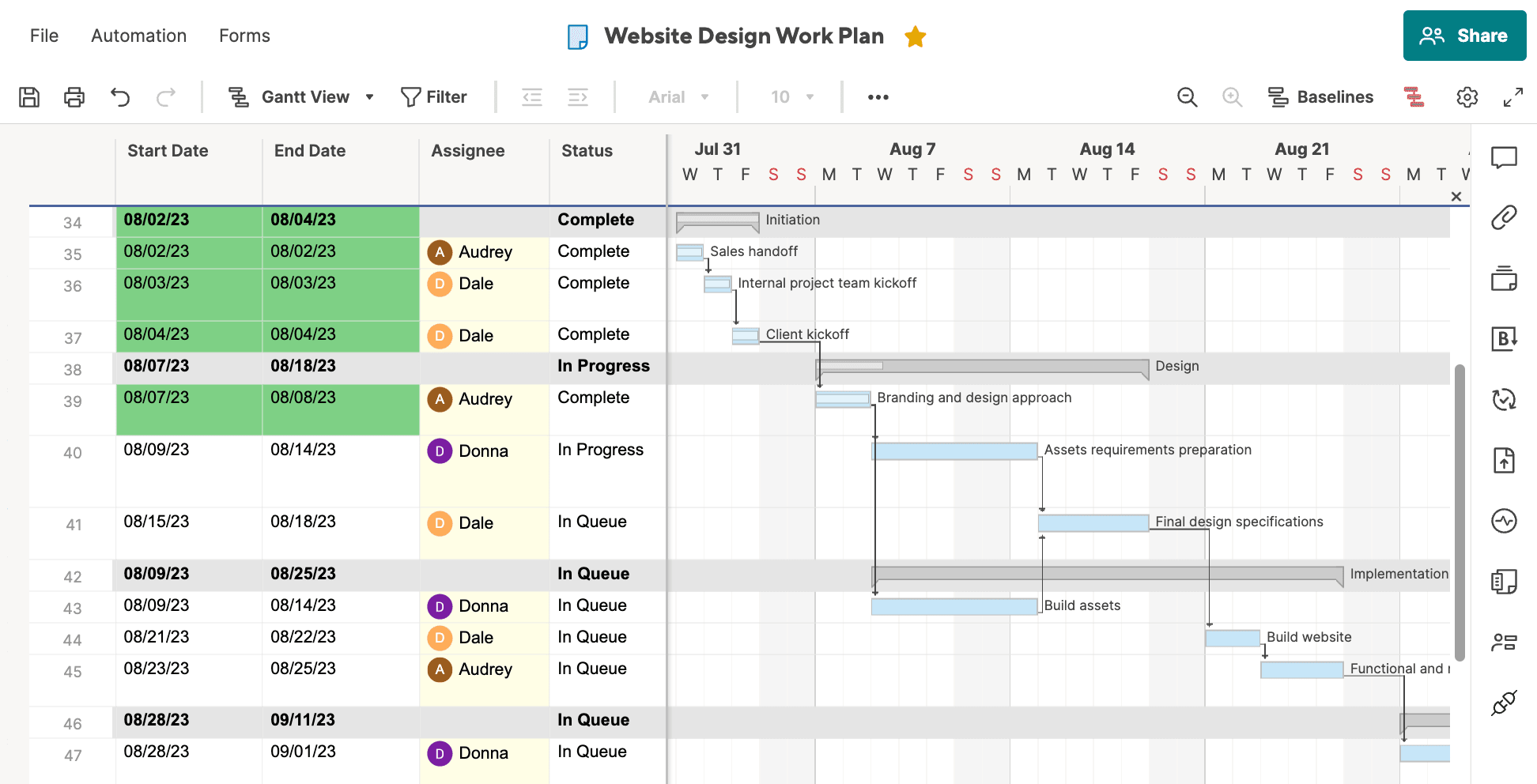Every successful project begins with a clear plan, but keeping that plan visible and actionable as work evolves is where the real challenge begins. Tasks multiply, priorities shift, and deadlines compete for attention, making it easy to lose sight of the bigger picture. A Gantt chart bridges that gap by turning your entire timeline into a single, visual source of truth. It connects tasks, tracks dependencies, and helps teams stay aligned around shared goals — all while keeping complex projects easy to understand at a glance.
To help teams plan with greater precision in 2025, we have curated 21 free Gantt chart templates designed for a variety of industries, workflows, and project types. From simple timelines to fully detailed tracking systems, each template provides a foundation for mapping work, organizing schedules, and maintaining visibility from start to finish. These templates are flexible enough to adapt as priorities change, giving every team member a clear view of progress and accountability.
Key takeaways
- Template selection: choose based on your project’s complexity and team size. Simple projects with fewer than 20 tasks work best with basic templates, while larger teams benefit from options that include resource management features.
- Built-in efficiency: use Gantt chart templates to eliminate repetitive setup work. Pre-built frameworks can be reused across multiple projects, saving hours of planning and setup time.
- Dynamic management: monday work management turns static templates into flexible project systems with drag-and-drop scheduling, AI-powered updates, and real-time collaboration that scales with your team.
- Common pitfalls: avoid the four mistakes that often derail projects — overcomplicated timelines, missing dependencies, irregular updates, and underestimated time requirements.
- Essential structure: every effective Gantt chart includes six key components — task lists, timelines, task bars, dependencies, milestones, and resource assignments that work together as a complete planning system.
What are Gantt chart templates?
A Gantt chart template is a ready-made framework that displays project tasks as horizontal bars across a timeline. This format provides an instant view of when work begins, how long it will take, and where tasks overlap or depend on one another — all without the need to design a chart from the ground up. By using a structured template, teams can focus on strategy and execution rather than setup.
Adopting proven project management methods pays off in measurable ways. Research shows that organizations using standardized practices waste 28 times less money than those that do not, underscoring how much efficiency improves when teams follow a consistent process.
In essence, a Gantt chart template gives your project a clear blueprint for progress. It outlines the essential framework, guiding teams through planning, scheduling, and tracking so everyone stays aligned from kick-off to completion.
Gantt charts vs Gantt chart templates: difference explained
Although both tools look similar at first glance, they serve different purposes in project planning. A Gantt chart is created for one specific project, built around its unique tasks, timelines, and dependencies. A Gantt chart template, by contrast, provides a reusable framework that can be adapted for any project, helping teams save time and maintain consistency across workflows.
Building a Gantt chart manually means entering every task, deadline, and dependency one by one — a process that can quickly become repetitive. Templates simplify that effort by offering a structured layout you can customize with your own project details, making it easier to launch new plans and keep work organized from the start.
Essential elements every Gantt chart template must include
Every functional Gantt chart template needs specific components that work together. Without these elements, your template becomes just a pretty picture rather than a practical planning tool:
- Activity list: all project activities arranged vertically.
- Timeline: the calendar view showing project duration.
- Task bars: visual blocks showing when each task happens.
- Dependencies: lines connecting related tasks.
- Milestones: diamond markers for key deadlines.
- Resource assignments: names showing who does what.

21 free Gantt chart templates for project success
Strong project planning starts with a clear view of tasks, timelines, and responsibilities. Gantt chart templates make that possible by turning complex schedules into organized, visual plans your team can follow with ease.
Below are 21 free Gantt chart templates you can use in Excel, Google Sheets, or your preferred project management platform. Each one suits different project types and team structures, helping you plan smarter and deliver work on time.
Simple Gantt chart template
Perfect for your first Gantt chart or small projects with under 15 items. This template strips away complexity, showing only task names, dates, and basic timeline bars.
Basic Gantt chart template
One step up from simple, this template adds task dependencies and milestone tracking. You’ll see how delays in one area affect the rest of your project.
Excel Gantt chart template
Built for Microsoft Excel users, this Gantt chart in Excel template uses familiar formulas and formatting. You can customize colors, add calculations, and integrate with other spreadsheets your team already uses.
Google Sheets Gantt template
This cloud-based option lets multiple people update progress simultaneously. Changes save automatically, and you can access your project plan from any device.
Project management Gantt template
This comprehensive project management template is built for structured project environments that demand detailed tracking and visibility. It covers resource allocation, budget management, and progress monitoring, helping teams stay aligned from planning through delivery.
Designed to work seamlessly with dynamic platforms such as monday work management, it is ideal for managing complex initiatives that require precision and cross-functional collaboration.
Weekly Gantt chart format
Shows daily task breakdowns for sprint planning or short-term projects. Each week gets detailed visibility with a weekly schedule template, helping teams focus on immediate priorities.
Monthly Gantt timeline template
Designed for projects spanning several months, this monthly schedule template in Excel provides high-level milestone tracking without daily clutter.
Construction project Gantt sample
Includes permit phases, inspection points, and weather delays specific to construction workflows. Contractors use this Gantt chart for construction project to coordinate trades and materials.
Software development sprint template
Built for agile teams that need structure while maintaining flexibility. This template combines sprint planning and visual tracking to keep development cycles organized and transparent.
- Sprint boundaries: define clear start and end dates for each iteration.
- Story points: estimate workload and balance team capacity effectively.
- Release cycles: visualize progress toward upcoming launches and deliverables.
Marketing campaign Gantt chart
Tracks content creation, approval rounds, and launch coordination. Marketing teams use this Gantt chart for marketing plan to manage multiple stakeholders and creative iterations.
Event planning timeline template
Highlights venue bookings, vendor deadlines, and day-of logistics. Event planners rely on a Gantt chart for event planning to track everything from initial planning through post-event wrap-up.
Resource management Gantt
Focuses on workload distribution across team members. Managers can spot overallocation before it causes burnout or delays.
Multi-project portfolio template
Manages multiple projects in one view with shared resource tracking. Executives see how projects compete for attention and resources.
Agile Gantt chart template
Combines sprint planning with visual timelines. Agile teams maintain flexibility while providing stakeholder visibility.
Product launch timeline
Coordinates development, testing, marketing, and support activities. Product managers align cross-functional teams around launch dates.
Client project tracker
Includes client touchpoints, approval stages, and deliverable milestones. Service providers maintain transparency throughout client engagements.
Task management Gantt
Provides granular work item tracking with sub-items and detailed progress monitoring. Complex projects become manageable through systematic breakdown.
Team collaboration template
Emphasizes communication workflows and shared ownership. Teams prioritize transparency and collective accountability.
Budget tracking Gantt
Integrates cost monitoring with timeline management. Project managers track financial progress alongside schedule adherence.
Risk management timeline
Maps potential problems and mitigation strategies into project planning. Teams prepare for uncertainties before they impact delivery.
Strategic planning template
Tracks long-term initiatives and organizational goals. Leadership teams monitor strategic progress across quarters or years.
How to select the perfect Gantt chart template
Choosing the right Gantt chart template starts with understanding what your project needs. The best fit depends on factors like complexity, team size, duration, and the level of tracking required. Use the guidelines below to evaluate these elements and find a template that supports your project from planning to delivery.
Evaluate project complexity and scope
Start by honestly assessing what you’re managing. Simple projects need different templates than complex initiatives with multiple workstreams.
Consider these factors when evaluating your needs:
- Task count: under 20 tasks works with basic templates.
- Team size: larger teams need resource management features.
- Duration: match template granularity to project length.
- Dependencies: complex relationships require advanced tracking.
Consider team size and collaboration needs
Team structure plays a major role in choosing the right template. Smaller teams can stay productive with simple layouts that track basic tasks and timelines. Larger groups, however, benefit from templates that include resource allocation, communication tracking, and role visibility to maintain coordination across departments.
When supported by a modern and intuitive platform such as monday work management, these collaboration features scale effortlessly. Real-time updates, shared dashboards, and transparent ownership help distributed teams stay aligned without relying on constant check-ins or manual status reports.
Match timeline to project duration
Your project’s length should guide the level of detail in your Gantt chart. Short-term initiatives benefit from weekly or biweekly templates that make it easy to track day-to-day progress and quick milestones. Longer projects, such as strategic or multi-year plans, work better with monthly or quarterly views that highlight broader phases and key deliverables.
Choosing the right timeline view helps teams stay focused on what matters most at each stage without getting lost in unnecessary detail.
Assess required features and functionality
Identify the features that directly support your project goals. The right template should make planning easier, not more complicated.
- Dependency tracking: visualize how tasks connect and where delays may occur.
- Resource management: balance workloads and prevent overallocation.
- Budget monitoring: keep financial progress aligned with project timelines.
- Milestone visualization: highlight key checkpoints and delivery targets.

How to create your custom Gantt chart template in 6 steps
Creating your own Gantt chart template takes a bit of upfront effort, but the payoff is significant. A well-built template gives you a repeatable system that saves time, improves consistency, and aligns your team around a single project framework.
Follow these steps to design a version tailored to your workflow and ready to reuse across future initiatives.
Step 1: map your project workflow
Document the phases that repeat across your projects. Look at recent work to identify patterns in task sequences and common bottlenecks.
Step 2: break down tasks and subtasks
Use work breakdown structure principles to find the right detail level. Start with major phases, then add specific deliverables without going too granular.
Step 3: establish task dependencies
Most tasks follow finish-to-start patterns — one must complete before the next begins. Using Gantt charts with dependencies helps map these connections to prevent scheduling conflicts.
Step 4: assign team members and resources
Choose between role-based assignments (“Designer”) or specific names. Role-based templates offer more flexibility for changing teams.
Step 5: set milestones and critical deadlines
Identify checkpoints that appear in every similar project. These become your progress markers and communication points.
Step 6: apply visual customization
Develop consistent color coding and formatting. Visual patterns help teams quickly understand status and priorities.
5 key benefits of Gantt chart templates in project management
Using Gantt chart templates brings structure and efficiency to how teams plan, track, and deliver work. The right template makes it easier to see progress, allocate resources effectively, and keep everyone aligned around shared goals. Below are five key ways these templates improve project management outcomes.
Comprehensive project visualization
Visual timelines instantly communicate project status to any stakeholder, a critical function in large enterprises where research finds only 61% of employees are satisfied with transparency. Executives grasp progress without detailed briefings, while teams understand their place in the bigger picture.
Optimized resource distribution
Gantt chart templates help visualize team capacity across multiple projects, reducing the risk of overallocation or idle time. When paired with modern platforms such as monday work management, resource tracking becomes effortless. Real-time workload views and capacity insights make it easier to balance assignments and keep projects moving efficiently.
Seamless team coordination
Standardized formats reduce confusion about where to find information. Everyone follows the same patterns, making collaboration more efficient.
Proactive deadline tracking
Dependencies and critical paths become visible before they cause problems. Teams spot potential delays early enough to adjust plans with a Gantt chart with milestones.
Real-time progress monitoring
Updates happen within the workflow rather than through separate reports, a significant advantage when research shows nearly half of organizations lack access to real-time KPIs. This improves transparency while the administrative burden decreases.

4 critical mistakes that derail Gantt chart success
Even the best-designed Gantt chart can fail if it is not used effectively, with any teams fall into the same avoidable traps that turn a helpful planning tool into a source of confusion.
Recognizing these common mistakes early allows you to build more realistic plans, keep timelines accurate, and maintain trust in your project data.
Creating overly complex timelines
Start simple and add complexity gradually. Teams abandon templates that require excessive maintenance relative to their value.
How do you know if your timeline is too complex? If updating takes longer than the actual work, you’ve gone too far.
Missing crucial task dependencies
Hidden connections between tasks cause unexpected delays. Review dependencies with people doing the actual work — they know connections managers might miss.
Neglecting regular updates
Outdated templates lose credibility fast. Establish update rhythms and assign clear ownership for maintenance.
Underestimating time requirements
Build buffer time for unexpected issues and scope changes. Historical data provides more accurate estimates than optimistic guesses.
Elevate your project management with monday work management
Traditional templates provide structure, but they often fall short when projects evolve and teams grow. As work becomes more distributed and change happens faster, static tools cannot keep up with shifting priorities or real-time updates. This gap is clear in the data: 45% of senior leaders believe change is managed “very well,” while only 23% of individual contributors agree. Bridging that divide requires more than templates — it calls for a dynamic platform that keeps every project connected, transparent, and adaptable.
Platforms like monday work management help turn traditional Gantt planning into a living, collaborative system that evolves with your projects. The features below show how it helps teams automate routine work, connect tools, enhance accuracy, and create fully customized Gantt views that reflect real progress every day.
From static templates to dynamic Gantt views
monday work management transforms Gantt chart software from documentation into living project orchestration. Drag-and-drop adjustments instantly recalculate timelines and dependencies.
Your project view always reflects current reality. No more outdated spreadsheets or manual updates across multiple documents.
Advanced automations that save hours weekly
Stop wasting time on repetitive project updates. monday work management’s automation engine handles routine tasks so your team can focus on high-value work.
- Status-triggered notifications that alert the right people at the right time.
- Automatic timeline adjustments when dependencies shift.
- Custom workflow rules that match your team’s unique processes.
200+ integrations for seamless workflow connections
Connect your Gantt charts with the tools your team already uses. monday work management eliminates data silos by bringing everything into one collaborative workspace.
- Sync with Microsoft Office and Google Workspace for document-driven projects.
- Connect development tools like GitHub, Jira, and GitLab.
- Integrate marketing platforms including HubSpot and Mailchimp.
Powerful AI features that enhance planning accuracy
Let AI do the heavy lifting in your project planning. monday work management’s intelligent features help create more realistic timelines and resource allocations.
- Smart duration estimates based on historical project data.
- Automated dependency detection to prevent scheduling conflicts.
- Resource optimization suggestions that prevent team burnout.
Visual template customization for perfect Gantt charts
Create templates that perfectly match your project needs. monday work management’s visual customization tools help you build Gantt charts that communicate exactly what your stakeholders need to see.
- Custom fields and column types for industry-specific information.
- Conditional formatting that highlights risks and opportunities.
- Multiple view options from high-level roadmaps to detailed daily schedules.
Frequently asked questions
Is there a Gantt chart template in Excel?
Yes. Excel includes built-in Gantt chart templates available through the template gallery. You can also create a custom version by using stacked bar charts and applying conditional formatting to display project timelines, durations, and task dependencies.
Can I create a Gantt chart template in Word?
Word does not include built-in Gantt chart functionality, but you can create a simple timeline using tables and shape tools. For more advanced features such as automatic calculations, dependencies, and progress tracking, Excel or a dedicated project management platform is a better choice.
How do I make a Gantt chart template in Google Sheets?
Google Sheets offers free Gantt templates in their gallery that you can copy and customize. You can also build templates from scratch using conditional formatting and formulas, or work from a schedule template for Google Sheets with automatic saving to Google Drive for team access.
What’s the most effective free Gantt chart template for small teams?
The most effective template depends on your specific needs, but if you want a free Gantt chart, Google Sheets templates work well for small teams needing basic timeline visualization and collaboration. For advanced features like automation and resource management, platforms like monday work management offer more comprehensive solutions.
How do Gantt chart templates improve project delivery times?
Gantt chart templates improve delivery by providing visual timelines that reveal dependencies, resource conflicts, and critical paths. For long-term goals, a Gantt chart for business plan helps teams identify potential delays early, coordinate more effectively, and maintain consistent planning standards across projects.
Can multiple team members update Gantt chart templates simultaneously?
Yes, cloud-based templates in Google Sheets allow real-time collaboration where multiple users can update simultaneously. Platforms like monday work management expand this with advanced features including automated notifications, permission controls, and audit trails for enterprise teams.
 Get started
Get started 

